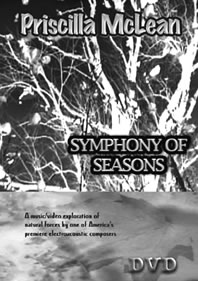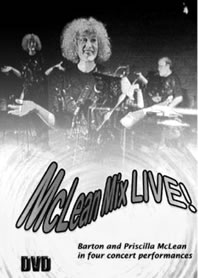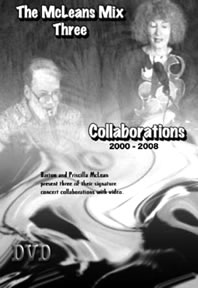McLean DVDs
Priscilla McLean: Symphony of Seasons
DVD-Video, 2009, MLC Publications DVD , ISBN-10 0-9824753-0-6 /ISBN-13 978-0-9824753-0-0; available from Barton and Priscilla McLean, 55 Coon Brook Road, Petersburg, New York 12138, USA; electronic mail mclmix@cisbec.com; Web members.cisbec.net/mclmix/mlcdvd.html.
The McLean Mix: The McLean Mix Live!
DVD-Video, 2009, MLC Publications DVD, ISBN-10 0-9824753-1-4/ ISBN-13 978-0-9824753-1-7; available from Barton and Priscilla McLean, 55 Coon Brook Road, Petersburg, New York 12138, USA; electronic mail mclmix@cisbec.com; Web members.cisbec.net/mclmix/mlcdvd.html.
The McLean Mix: Three Collaborations 2000-2008
DVD-Video, 2009, MLC Publications DVD , ISBN-10 0-9824753-2-2 /ISBN-13 978-0-9824753-2-4; available from Barton and Priscilla McLean, 55 Coon Brook Road, Petersburg, New York 12138, USA; electronic mail mclmix@cisbec.com; Web members.cisbec.net/mclmix/mlcdvd.html.
Reviewed by Elizabeth Hinkle-Turner
Denton, Texas, USA
 |
 |
 |
I have known Barton and Priscilla McLean for years and it was a great pleasure to receive copies of their DVD offerings in the mail. As I have seen nearly all of the pieces collected here in live performance, I was especially interested in determining how well they translated to a DVD experience. The McLeans have been touring and making music as independent creative artists for multiple decades and call upstate New York home when they are not traveling the U.S. and the world. Their spirit and philosophy are well articulated and documented in publications such as Priscilla’s engaging and amazing book, Hanging Off the Edge, and articles featured in Perspectives of New Music and Journal SEAMUS (full bibliography at members.cisbec.net/mclmix/articlesreviews.html). This spirit and philosophy as well as their home location are an integral part of the pieces found on the DVDs and are most obviously evident in Priscilla McLean’s The Symphony of Seasons (2001-2003).
Priscilla began this first work in video after spending considerable time observing the video production process of the duo’s Rainforest Images (1993) collaborator, Hasnul Saidon. Priscilla is frank about the considerable time and expense that can go into video creation and Barton further shares that from the beginning, the Mix made the decision not to grab onto the latest trends and technologies for their own sake. Instead, he comments, “we feel that this is the quickest way to artistic obsolescence. In our camera work, as well as our post-production choices, we try instead to pose universal themes and tools that transcend the video fad of the moment,” and adds, “I think that general statement has been said repeatedly about our music as well” (personal communication). I must say that as a composer and video artist myself who is bound by both aesthetic and financial concerns, I heartily agree with the sentiments of the McLeans and feel that this perspective is born out by the high artistic integrity of the three DVDs in general and The Symphony of Seasons in particular.
Opening The Symphony is Jewels of January. Priscilla began gathering footage for this work around their farmhouse setting and fleshing out ideas for a complete four-movement piece in 1999 with completion in 2003. The videos were completed first and then, as the composer reports about the soundtracks, “the music just burst forth” (personal communication). The initial film material for Jewels of January was ice formations at a nearby stream, and I agree with Priscilla that the careful visual study of the ice in various stages of growth and decay is both contemplative and compelling. In fact, of the four movements, Jewels remains my favorite from its stark yet rich black, white, and grey imagery to its simple but stereophonically interesting soundtrack (this is a great video to view wearing headphones which is one of the ways I experienced all of the DVDs).
Movement two, The Eye of Spring, was the least successful movement for me, although I certainly like the idea behind the work which Priscilla states as being about spring and fecundity and how it would feel to be a (sexual) flower opening up to whatever came by (whew!). As the composer adds, “This is a piece only a woman could create, I am sure!” (personal communication). The soundtrack for Spring features Ms. McLean’s powerful siren-like voice and works well on its own without the video accompaniment which I felt suffered a bit from too many blurry effects. However, July Dance, movement three, is a great video effect romp with dancing and shimmering trees and other summer images. Since I spend my Julys here in Texas where it becomes so hot that the heat creates visual waves in front of everything outside, I related easily to this piece!
Finally, the work closes with Autumn Requiem, a collaboration of Barton and Priscilla. At 26 minutes, it is the longest of the movements and I have seen this work both live and on DVD. One might think that such a lengthy video would be tedious, but quite the opposite is the case; the beautiful autumn images are so intriguing and the effects subtle and original enough to retain interest. Once again a rich and compelling soundtrack recorded flawlessly and utilizing Ms. McLean’s voice singing portions of the requiem mass and other selections and a variety of electronic sounds and found object instruments constructed and collected by the couple over the years completes the work.
The McLean Mix Live! DVD features four live performances by the Mix and successfully combines live footage with processed video sequences for variety and interest. Much more than a “concert film,” the Live! DVD offers the pieces and video “commentaries” on the pieces. An example of this is Priscilla McLean’s In the Beginning (2000), that opens the DVD. During the almost 17-minute work, one gets occasional glimpses of the concert setup but for the most part one is treated to the video portion of the piece (a collaboration of Priscilla and A. J. Jannone) superimposed with varying degrees of transparency on Priscilla’s face performing a virtuosic series of vocalizations recalling for me the “conversations” of György Ligeti’s Aventures and Nouvelles Aventures. The video superimpositions add an obvious “Mother Nature” element to the piece but in general simply convey a primeval and organic essence which I think was most likely the composer’s intent. This is a good illustration of how live performances and pieces can be effectively “discussed” by their creators long after the concert experience has finished, and I like this idea.
Next on the DVD is Barton McLean’s Happy Days (2000), featuring clown-acting, percussion, music boxes, party hats, and a variety of other fun stuff. Barton gamely plays “the straight man” (really, you can put a party hat and a lei on Barton but in the end he remains the consummate gearhead geek!), here leaving all the good lines to Priscilla who once again shows her marvelous performance skills. This particular selection is simply a recording of a live performance. All-in-all, the work is fun and enchanting. With Wilderness (1989) by Priscilla McLean, we are back to more of a “video as commentary” concept and this piece is primarily a recitation with soundtrack. I thought that Priscilla’s vocal expertise was on even more amazing display here than in the first selection and enjoyed her added theatrics as well. The piece itself is a realization of Carl Sandburg’s poem, “Wilderness,” and she certainly does justice to the work. Earlier I commented humorously on Barton’s “gearhead” status but the footage of this piece in particular showcases how valuable such status is to the duo. Priscilla gets on beautifully and easily with her dramatization in large part because Barton never misses a cue. Continually adjusting knobs, tweaking computer applications (many of the works on these DVDs utilize Barton’s amazing abilities with Max/MSP), twiddling flexatones and a variety of other instruments, his “behind the curtain” mechanizations are a kinetic joy to view. Wilderness is described in the DVD program notes as a “staple of McLean Mix concerts since 1989” and, indeed, I can remember the first time I saw it under less than ideal circumstances in a basement room at Oberlin College. Still, then as now, Priscilla’s fabulous vocalizations and Barton’s active instrumentals are intriguing and fresh; the piece has aged well.
Finally, Magic at Xanadu (MAX) by Barton McLean features his “Composers Playpen” computer program written in Max/MSP. The piece was inspired by the Samuel Coleridge poem, “Xanadu.” Mr. McLean writes in his program notes that central to the idea of the software is the initiation and changing of melodic, harmonic, and rhythmic loops in real time. Most of the loops are pre-recorded with a few recorded and modified during the course of the performance, while a third musical line is performed on the keyboard. The composer writes that this makes for a virtuosic live event where he must modify up to 14 musical ideas at once. Unlike the other three pieces on the DVD, filmed at Engine 27 in New York City in 2000, Magic at Xanadu was recorded at the Knickerbocker Theatre in Holland, Michigan, in 2008. Magic begins with almost a toy piano-like riff that is then continuously layered and filtered and developed. The video here is a terrific display of Barton at work; one gets to see the music he is using, his hands on the computer and keyboard, all of the inner workings of a live interactive piece up close and personal. Occasional video effects are used to create a surreal visual study in keeping with the music. I enjoyed having a front row seat here, especially since I have not seen this piece live.
The third disc, Collaborations 2000-2008, provides another excellent visual chronicle of this duo’s pieces and performances. Most interesting is that each of the collaborations here is unique in nature from the others. The first offering, MILLing in the ENNIUM (2001), is a more traditional collaboration with Priscilla creating the video and Barton creating the soundtrack. As one might imagine from the title, the work is a collage both sonically and visually. From the opening “rising sun” and music recalling 2001: A Space Odyssey to the images of a variety of musical and religious cultures, one is invited to reflect upon history, and, actually, each time I saw this (once live and twice in my studio), different ideas were conjured in my mind. The work progresses slowly so be prepared to sit with it awhile and really concentrate on what it has to offer.
Jambori Rimba was primarily completed during the couple’s extended residency in Malaysia in 1996, and the soundtrack features an electronic drone composed by Barton and sounds of the rainforest in Borneo recorded by both he and Priscilla. The video was done by Malaysian video artist, Hasnul Saidon, and, as mentioned earlier, became the inspiration for Priscilla to do her own video work in The Symphony of Seasons. One can see in this initial piece many of natural themes and video processes that have become a part of Priscilla’s later pieces. Jambori Rimba was originally an installation and what is found on the DVD is a collaborative performance that the McLeans created from the installation materials. What strikes me most about Jambori Rimba is that it is a piece of subtle layers, and upon each viewing one can choose to grasp the whole or follow the thread of one of its parts.
In Natural Energy (2008) both McLeans had a hand in the video and soundtrack. Much of the soundtrack material was created by Barton using Max/MSP, generating an ostinato over which melodic ideas are improvised using various whistles and flutes, the ever-present flexatone, Priscilla’s voice, and some invented instruments. Video was created by Priscilla with input from Barton. Of the works featured on all three DVDs, Natural Energy is definitely the most abstract. However, although one may not actually see literal images of an environmental nature, they are certainly evoked. The viewer is given the essence of the natural phenomena if not the phenomena itself. For example, the extended first portion of the work imparts the idea of flames but whether it is the flame of a candle or the physical “flame” that ignites a dancer or musician is never explicitly stated. Similarly, water is evoked next but it is more fluidity than literal water itself. Altogether, this is something new from the McLean Mix which may suggest an intriguing evolution of their style for the next decade of performances. For a behind-the-scenes look at how Barton and Priscilla collaborated and created the sounds for Natural Energy, a “bonus track” of rehearsal footage is included on the DVD.
While some visual artists and filmmakers may quibble with the aesthetics of a few of the McLean’s video processes and title settings, for the most part these DVDs maintain visual integrity and most importantly, reflect the visual taste and sensibilities of the Mix which is, of course, of utmost importance here. I must say that the audio, both in terms of the soundtracks for the works and the digital recording, is outstanding in quality and easily passed the rigors of my new home sound system and my new stereo headphones. The DVDs come nicely packaged in sturdy plastic containers (attention, librarians and other preservationists!) so one certainly gets a high quality product for home and institutional libraries.
To have these three DVDs in one’s personal and university collection is essential, I think, if one is to have a comprehensive representation of American electroacoustic music. The McLeans have been a unique fixture on the American music (and also international) scene for decades and they embody a creative and entrepreneurial integrity that is inspiring and demands acknowledgement and recognition. Those of us who have known Barton and Priscilla for many decades know them to be fun and imaginative people and performers who are generous with their advice, time, and energies (I can think of at least two occasions off-hand when the Mix definitely picked me up when I was feeling quite low creatively and professionally). I additionally encourage the acquisition of Priscilla McLean’s Hanging Off the Edge as well, as it provides a great deal of back-story for the creation of the pieces featured on the DVDs and other works; the DVDs and the Priscilla McLean book represent “the essential McLean Mix” for me. Further background and writings by the McLean’s about their music, their travels, and their tours are extensively showcased at their Web site (members.cisbec.net/mclmix/index.html) .